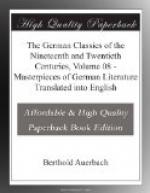One might say, in short, one extreme challenged the other. When people had banished the old professional clown from the stage, they felt the necessity of running about themselves as clowns. The sober, enlightened age protested against the old folk-tales with goblins, gnomes, elves, and other kindred sprites, but, to make up for it, thousands of living caricatures played in their own rooms the part of goblins and gnomes, and lady shepherdesses appropriated the roles of the elves, nixies, and nymphs.
This phenomenon, however, leads to facts of much deeper significance for the history of culture. Let us first define the conceptions. The words “rococo” and “pigtail” at first applied only to the plastic arts; we are, however, gradually becoming accustomed to employ them to designate the whole period of culture. That is right and commendable, for those words have been taken from real life, from experience by the senses, whereas, as a rule, we almost always fabricate lifeless scholastic terms for such things.
The Rococo—in the plastic arts—presupposes the Renaissance, and I believe it has even been called the Renaissance gone crazy. One might say more justly that when the Renaissance got intoxicated it became the Rococo. And if the Rococo is the drunken debauch of the Renaissance then the Pigtail would be the seediness which follows after it.
But I must rein in my steed to a quieter pace and give a more scholastic definition.
In the Renaissance, antique forms were born again, at first within and beside the medieval, finally replacing them entirely. But the new age of the sixteenth century had new needs, new senses, new passions, which the antique could satisfy no more fully than could the Gothic. When a person is no longer an old Roman he cannot quite build and fashion like the old Romans. For this reason the antique was pulled and stretched and fitted on the new man as well as could be managed. It is, however, just as hard to adapt forms of art as to alter coats which have been cut out for some one else’s body. Only a few of the greatest architects and sculptors succeeded for a little while in reconciling the inner contradiction between the new life and the old art. No period of art had so short a flourishing period as the genuine Renaissance; when it came into the world it bore the birthmark of mannerism on its forehead.
This mannerism in its fulness and maturity is the Rococo. The burly men and women bubbling over with life, in whom the stormy spirit of the age of discovery and invention, of social revolution and religious reformation, had not yet spent itself, finding the forms of the antique too confined and yet not wishing to give them up, pulled and stretched them, added to them scrolls and crossettes, nay, even shattered them to fragments and then held fast to their ruins, indeed even went so far as to find these caricatures and ruins more beautiful than the original. The Rococo is violent in chains, insolent in constraint, drunken in sobriety. It is the art of a rich, voluptuous, mystic, restless age.




